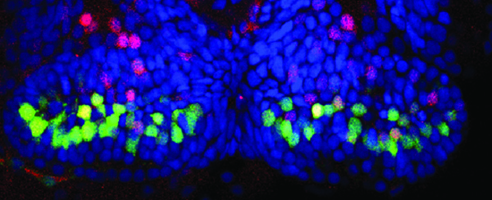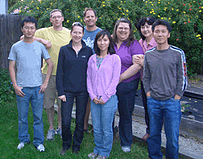Most of us ate turkey with friends and family in a warm house yesterday. Today many are shopping. Meanwhile on Long Island, Staten Island and the Jersey Shore, volunteer organizations are still hard at work cleaning up the mess from Sandy and helping people move their lives forward. Instead of Thanksgiving at home with family, military veterans volunteering with Team Rubicon probably ate a donated meal with fellow workers or community members. Maybe they got to rest their muscles for a day.
Tags: Northeast, New York, 2012, BioResearch Product Faire Event, Front Line event, New York City, Trade show, Biotechnology Vendor Showcase, Sales
Tags: biomedical research, Bioresearch, 2012, Life Science Market Update., Denver, Front Line event, CO, Colorado, National Jewish Health University, NJH
The California Institute for Regenerative Medicine (CIRM) has just celebrated the opening of its latest state-of-the-art research labs, at UC Santa Barbara's Center for Stem Cell Biology and Engineering. The new labs are located in the Bio II Building next to the Life Sciences Building on the eastern edge of campus. The 10,000sf, $6.4M wholesale renovation has taken about 5 years to go from concept to full realization. All funding came from CIRM or private donations, to allow faculty the flexibility to study the full range of stem cell technologies, without regard to federal funding limitations. The new Center is part of the Neuroscience Research Institute at UCSB.
Tags: CA, Stem cell research, New research facilities, new science wet labs, Southwest, California, 2012, University of California Santa Barbara, Funding, Front Line event, UCSB
Though the general consensus seems to be that the Northeast weathered deadly storm Sandy relatively well thanks to warnings and emergency plans put into action, there were unexpected casualties beyond the loss of over 80 human lives. Massive flooding in the lower New York Metro Area was not on the radar to the extent that it actually transpired, and basements that were thought to be flood-safe turned out not to be. That was the case at New York University's Smilow Research Center, where animal labs underground were inundated and approximately 10,000 research mice and rats drowned and lab equipment was ruined. On the upper floors, precious biological samples and reagents were lost as freezers and refrigerators shut down. Other research institutions in the area fared better.
Tags: Mount Sinai School of Medicine, Rockefeller University, Northeast, animal research, research mice, University of Texas, New York, 2012, Stony Brook University, Austin, Philadelphia, MSSM, BioResearch Product Faire Event, NY, Front Line event, science research, research laboratories, New York City, Research equipment, Stoneybrook
When a catastrophic natural disaster strikes, first responders often make the difference between life and death for potential victims. Training, preparedness and valor play a part in successful rescue efforts, but so do good tools. Sometimes that tool is as basic as an axe or a flashlight, or a life vest or life raft. The recent mega-storm in the NE has us thinking about the kinds of tools that science research is coming up with to address emergency and crisis situations, both during and in the aftermath of a major event. To that end, we're taking a look back today at some of our earlier blogs on life science research invention to see what kinds of scientific solutions are on the horizon (or already here) to aid in disaster relief and recovery efforts.
Tags: UW, Ozcan Nano/Bio Photonics Lab, University of Washington, WSU, University of Minnesota Twin Cities, 2012, Los Angeles, Colorado State University Fort Collins, BioResearch Product Faire Event, UCLA, Front Line event, Seattle, Biotechnology Vendor Showcase, Colorado, St.Paul, scientist solutions, CSUFC, disaster relief
Michigan State University at East Lansing is priming plants to cope with two very different adversaries: hostile insects on Earth and the stressful conditions of space. Rather than furnishing them with armor or a spacesuit, researchers are working at the molecular level in order to make these plants more genetically hardy.
Tags: Michigan State University, Midwest, 2012, Michigan, Plant science, MI, Front Line event, East Lansing
Oregon State University in Corvallis is the state's leading public research institution and has recently announced that the 2011 fiscal year ending in June was its 2nd best ever for overall research funding levels (the prior year being #1 by a hair). In fact, 2011 was OSU's top year for private sector funding, at $35M, which inclulded payments for testing services, environmental analysis, prototype development and licensing fees. That figure represents a 42% increase over 2 years. Alll in all, Oregon State counted $261.7M in external funding in the 2011 fiscal year.
Tags: Oregon State University, Northwest, Oregon, 2012, Funding, Front Line event, marine science, OR, Corvallis, NSF, ORSTU
With the advances in microscopy and digital imagery today, it's not unusual to find yourself looking at visual representations from the micro-world of the lab that are truly beautiful to behold, both for what they tell us about the science of life and on an aesthetic level as well. Some of the images might be said to qualify as art. In the case of Greg Dunn, PhD Neuroscience 2011 from the University of Pennsylvania, neural art has become his profession, and departments of neuroscience across the US have commissioned his large, metallic and ink visions for their offices, libraries, and reception halls. Influenced by Japanese art, completely self-taught, and still very much the scientist with his subject matter, Dunn's work is quite simply spectacular, and a great deal more than an homage to the neuron.
Tags: Pennsylvania, Northeast, University of Pennsylvania, UPenn, Thomas Jefferson University, 2012, Neuroscience, Philadelphia, BioResearch Product Faire Event, Front Line event, ThomJeff
 |
| (Courtesy of College of Pharmacy web page) |
Tags: Bioresearch, Biomedical expansion, University of Texas, 2012, UTAust, UT Austin, Austin, Research, Front Line event
|
|
| (courtesy of HSC Core Research) |
The Zebrafish may have found their very own fountain of youth, or at least part of their brain has. Neurobiology and Anatomy research professor Richard Dorsky, at the University of Utah, is studying how the Wnt pathway in Zebrafish can grow new nerve cells in the hypothalamus. Researchers have found that Zebrafish can keep on growing new nerve cells even into adulthood. Dorsky's work understanding this mechanism of regeneration in the adult brain could ultimately offer insight into our own neuro-cognitive decline as a result of aging.
In the United States there are approximately 76 million baby boomers, and each year more and more are turning 65 years old. This means that maintaining a healthy functioning brain is becoming a higher and higher priority to a large portion of the population. At this time it seems inevitable that as we age, the normal brain will change physically and cognitively. This year it is estimated it will cost the U.S. $200 billion dollars to care for our 5.4 million Alzheimer’s patients, and the figure is expected to climb higher. In fact, by the year 2050 it is estimated that the cost of Alzheimer’s and other dementias will reach $1.1 trillion dollars. Add the devastating emotional impact on families faced with an elderly parent suffering from the disease, and it's clear why research into neuro-cognitive decline is so important.
It seems that the Dorksy lab is bringing us one step closer to being able to turn back the clock on the human brain. According to Dorsky, "Our research represents a significant contribution to the field because it ... can be used to shed light on the plasticity of the adult brain." Unlike humans, adult Zebrafish have a built in repair system for hypothalamus tissue damage in their brains. The fish’s neural stem cells lie in wait ready to respond to chemical signals of cell damage or death. Part of what makes the Wnt pathway so interesting is that it changes from its embryonic to adulthood. At the embryo stage, Wnt signaling is essentially an on switch that tells the neural stem cells to rapidly grow. This causes the rapid increase of progenitor cells. The progenitor cells arise from neural stem cells. With more development the progenitor cells differentiate into the brain's structures. But this changes in adult Zebrafish when the Wnt pathway becomes radically different.
 (courtesy of Dorsky lab)
(courtesy of Dorsky lab)
 |
| (Courtesy of Dorsky lab) |
In a recent article by Dorsky, Wnt signaling regulates postembryonic hypothalamic progenitor differentiation, he describes how his lab research determined how the Wnt pathway in adult zebrafish signals cell regeneration. In adults, the Wnt has to have perfect timing in order for the progenitor cells to grow and differentiate. The Wnt pathway has to first turn on to start the growth and differentiation, then later turn off again to grow properly. It can’t just stay on.
Moreover, the lab studied mice in order to see how the Wnt pathway translates in other animal models. The researcher found that the wnt pathway in mice acts to stop the differentiation of glial cells. Moreover according to Dorsky: "In adult mice, hypothalamic neurogenesis seems to be significant in the regulation of feeding behaviors due to environmental changes."
So, the sooner we can find a cure for Neuro cognitve decline and turn back the time on our aging brain the better we will all be. So, with the help of a little fish, in the future we might be able to grow new neuro tissue in the hypothalamus. Who knew that the Zebrafish light lead us to our own neuro fountain of youth.
Members of the Dorsky lab include:
 |
| (Courtesy of Dorsky lab) |
-Lisa Benko- Graduate Student-Characterization of Multipotent Spinal Cord Progenitors
-Rob Duncan- graduate student- Identification of Neural Stem Cells in the Zebrafish Hypothalamus
-Hyung-Seok Kim-Postdoctoral-Fellow-Tcf3 Targets in Spinal Cord Development
-Adam McPherson-Graduate-Student-Functional Analysis of Post-Embryonic Hypothalamic Neurogenesis
-Xu Wang-graduate student-lab manager- Wnt Signaling and Post-Embryonic Hypothalamic Neurogenesis
The Dorsky lab is part of the Department of Neurobiology and Anatomy which is located in the Wintrobe building adjacent to the school of medicine. The department occupies 17,000 square feet and has 13 department faculty researching: developmental biology, neuroscience, stem cells and regeneration, and neural disease and repair. The department currently uses several different animal models in its research: mouse, chicken, zebrafish, xenopus, and planaria.
Biotechnology Calendar, Inc. will be holding its 13th Annual Salt Lake BioResearch Product Faire Front Line event next on August 15, 2013. This professional show is an excellent opportunity for life scientists and lab equipment specialists to come together and discuss lab technologies to make every lab run at maximum efficiency. If you are unable to make it to our Utah show, these are other shows you might me interested in attending.
- 02/01/2013 13th Annual Houston BioResearch Product Faire™, located in Houston and situated at the Texas Medical Center.
- 02/06/2013- 8th Annual Mission Bay Biotechnology Vendor Showcase™ located in San Francisco and situated on the UC San Francisco Campus
- 06/20/2013 - 4th Annual Denver BioResearch Product Faire™ at the University of Colorado, Anschutz Medical Campus.
Tags: Bioscience research, Utah, university of utah, 2012, Front Line event, Salt Lake City


